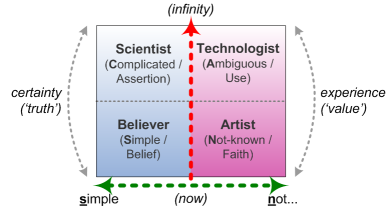Last week I had the pleasure to speak at the
IRM-EAC conference in London about "How To Implement Enterprise Architecture Agile From Scratch". Implementing Enterprise Architecture that way is actually my physical answer to my thoughts on Social Enterprise Architecture. For those of you who
follow me on twitter you might already have seen some tweets about my speech. I wasn't very active on my blog lately, because I was occupied in many other topics, but in general I have the plan to keep on putting my knowledge into the blog.
I also met
Tom Graves at the conference and we spoke a while about various things. Despite my lack of understanding some specific english terms which are not my standard vocabulary the conversation went quite fine. A couple of times Tom explained me surely cool things where my face must have went blank, because he paused and tried with different words afterwards. I shared a practical story of my daily work with him, where I (mis)used his
SCAN Framework in Architecture Shootout Sessions.
Obviously he has no obligation.
These ideas happen, because in the daily work we are quite often faced with very difficult problems where we need to give quick answers. I do not know if SCAN is the best framework for doing complexity assessments or not, but I decided to select it, because of its brilliant name. It is sometimes as simple as that. Using such a brilliant acronym to do a Complexity SCAN really helps, because the name sinks in. Due to my thinking about
GLUE, where I always try to find the optimal holistic flow I have extended into three dimensions:
- EPIC SCAN to understand why we are where we are. So very literally the EPIC of the current complexity.
- WISE SCAN to understand where we want to go. So very literally if it is WISE to go where we think we should go.
- PACE SCAN to understand at what speed we can change. So again very literally the PACE of the change.
Besides that very intense and interesting (and hopefully relevant) discussion Tom also triggered me (again) to write a book. Wow, tough one. But I thought about it for a while, and I kept on thinking about it. And that triggered something else with me. All of a sudden I had the urge to reinstall my Notebook, even though it was perfectly working. Actually that is a habbit of mine when I start something new. A new thinking process, a new approach. I leave old boundaries and thoughts behind me. Technically I copy all files into a network backup folder, then I reinstall the operating system and only install software when needed. The backup folder I do not touch or move back but only look into it when I really search for something. After one year of not touching that folder I delete it completley without even trying to look into it. I picked that way of thinking up from "
Simplify Your Life".
So now I am ready, but for what. I actually have started two books on
LeanPub (Thank you Tom for the recommendation). One book about "GLUE" and another book about "Implementing Social Enterprise Architecture in 100 days". I am not sure about the titles or what I must do in LeanPub and what I should not do. I then learned that I now have to invest a bit of time into
Dropbox, because that is the way to work with LeanPub. Actually a tool I had no use for so far. Fair enough, new ideas, new ways of working. Lets give it a try.
Lets see if the flow is coming. (I also decided to not reuse any of the content of my blog directly. I will most likely also redraw my images, because it helps me to re-order my thinking. I do not know where this leads and what the outcome will be, but I am very exicited to try it. It could be that I do not finish one of them, it could be that GLUE is only for me to straighten my thinking, it could be that both work out. I do not know, but I'll try my very best.




